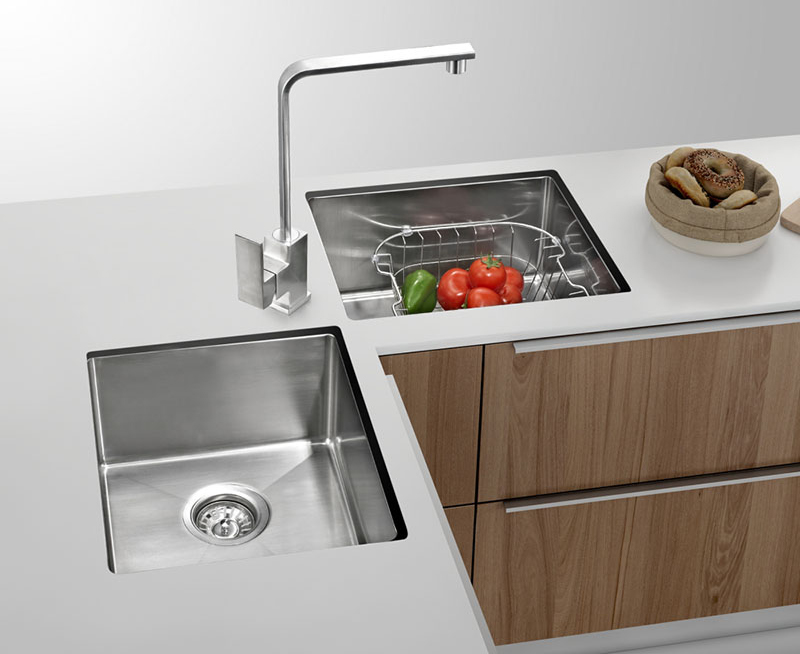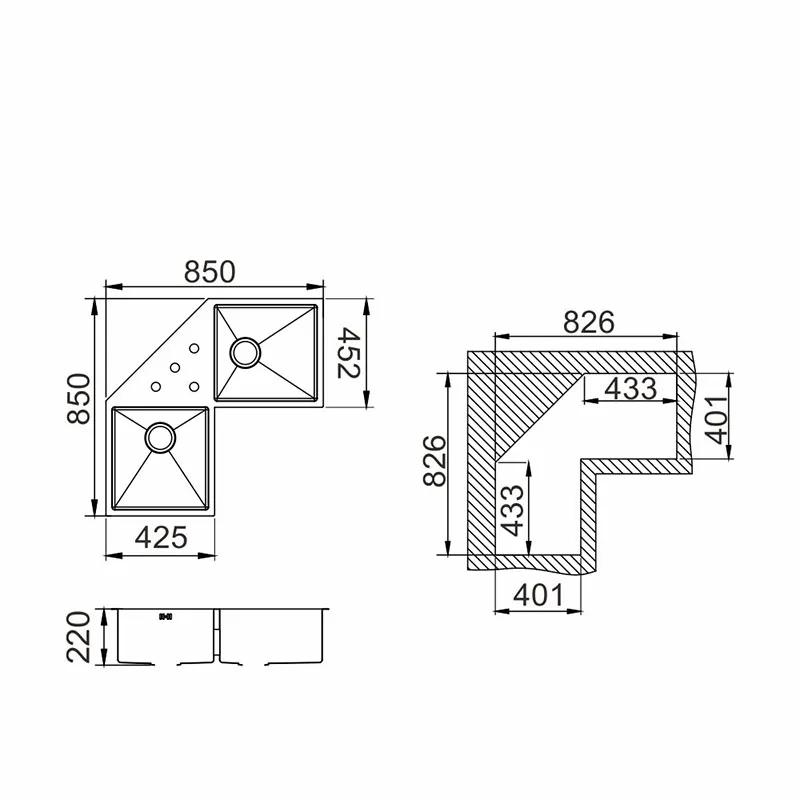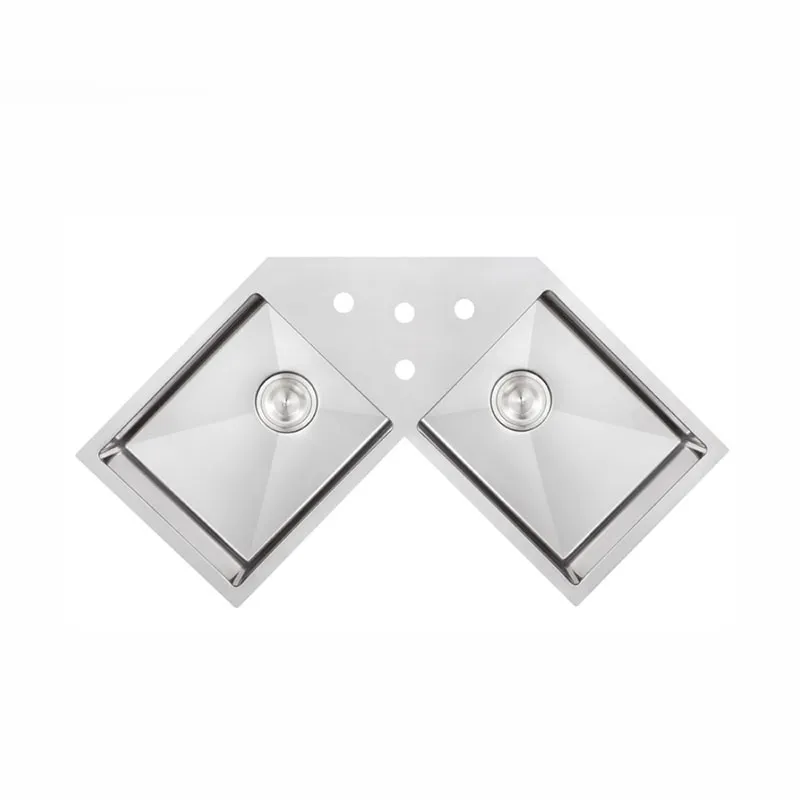In modern kitchen design, the sink is a core component of the kitchen. Choosing the right sink not only impacts the kitchen's aesthetics but also its efficiency. In recent years, as kitchen space demands have diversified, more and more consumers have turned their attention to the unique double bowl corner sink design.
Double bowl corner sinks, as a flexible solution for utilizing kitchen corner space, have become a popular trend in modern kitchen design. However, like any design, they also have their own unique advantages and disadvantages.
This article will delve into the advantages and disadvantages of double bowl corner sinks, helping you fully understand this sink design and make the most appropriate choice.

What is a double bowl corner sink?
A double bowl corner sink is a double-bowl sink installed in a kitchen corner. Unlike traditional parallel double-bowl sinks, double bowl corner sinks are typically L-shaped, or designed at a right angle, to maximize the use of kitchen corner space. The two halves of the sink are typically designed with a larger sink and a smaller sink to meet different kitchen needs. The double bowl corner sink design concept is to fully utilize the "dead corner" space in the kitchen, making it particularly suitable for families with smaller kitchens or limited space. This corner sink design effectively expands the kitchen's work area while reducing the sink's occupation of central countertop space.
What are the advantages of a double bowl corner sink?
Advantages of a double bowl corner sink:
1. Space-saving
2. Improved work efficiency
3. Optimized overall kitchen layout
4. Modern and stylish

1. Space-saving
One of the greatest advantages of a double bowl corner sink is its ability to maximize kitchen space. Traditional double bowl sinks typically require a larger countertop, while a double bowl corner sink cleverly utilizes the kitchen's corner space by placing the sink in a corner. For families with limited kitchen space or who require more countertop space, a double bowl corner sink is an ideal choice. It provides ample sink space without taking up too much central workspace.
Particularly in open kitchens, utilizing the corner sink space not only saves space but also creates a more compact and efficient kitchen layout. This space-saving design allows for more storage, creating a neater and more streamlined kitchen.
2. Improved Efficiency
A double bowl corner sink typically features two different-sized sinks: a large one and a small one. The large sink can be used for washing larger items, such as pots and bowls, while the small one is perfect for washing vegetables, fruit, or hands. This design increases the sink's versatility and makes it more efficient in daily use.
This dual-sink design allows users to perform multiple kitchen tasks simultaneously, reducing the need to frequently switch sinks and improving efficiency. For example, you can wash large items in the large sink while washing fruit or dishes in the small one, saving both time and effort.
3. Optimize the Overall Kitchen Layout
Modern kitchen design emphasizes flexible space utilization, especially in open or small kitchens. Maximizing every inch of space is crucial. A double bowl corner sink, as a corner-use design, not only enhances kitchen functionality but also creates a cleaner and more organized space. Placing the sink in a corner effectively separates the work area, washing area, and storage area, reducing overlap and clutter. In some cases, a double-bowl corner sink can also free up the central kitchen area for other functional areas, such as cooking or dining areas, thereby improving efficiency and comfort.
4. Modernity and Style
With the diversification of kitchen designs, double-bowl corner sinks are becoming more appealing not only for their functionality but also for their aesthetic. In particular, double-bowl corner sinks made of modern materials like stainless steel, ceramic, and quartz offer a simple and stylish look that adds a touch of modernity.
The corner design of a double-bowl corner sink often offers a unique and personal touch, making it an attractive option for families seeking a distinctive kitchen style. Whether featuring clean lines or innovative sink shapes, corner sinks blend seamlessly with other kitchen elements, enhancing the kitchen's visual appeal.

What are the disadvantages of a double-bowl corner sink?
Disadvantages of double bowl corner sinks:
1. High installation requirements
2. Relatively small sink operating space
3. Difficult to match certain kitchen styles
4. Difficult to maintain
1. High installation requirements
Due to their corner design, double bowl corner sinks require high installation requirements. Accurately measuring the size and shape of the corner space ensures the sink fits snugly on the countertop. During the design and installation process, corner sinks require particularly high precision in cutting and machining. Improper installation can result in a loose joint between the sink and the countertop, affecting both functionality and aesthetics.
In addition, because corners can create difficult-to-reach areas, sink installation requires special attention to waterproofing and sealing. Improper installation can lead to leaks.
2. Relatively small sink operating space
Although double bowl corner sinks can save space, their corner design often leaves them with a relatively small operating space. Compared to traditional center-mounted double bowl sinks, double bowl corner sinks can restrict access to large items, especially if the sink is small or the corner design is tight. If your kitchen requires extensive sink work (such as washing large areas of pots and dishes), a corner sink may feel cramped, hindering the user experience. Furthermore, the corner sink's layout may result in less-than-smooth water flow during washing, impacting cleaning efficiency.
3. Difficult to Compatible with Certain Kitchen Styles
While double-bowl corner sinks offer a modern and stylish look, they aren't suitable for all kitchen styles. In kitchens that prioritize symmetry or traditional décor, a corner sink may appear out of place or awkward. For example, in elegant, traditional kitchens, a double-bowl corner sink may not fit in with the overall decor, creating a sense of mismatch.
Therefore, when choosing a double-bowl corner sink, consider the overall kitchen style and design to avoid it becoming an outlier.
4. Difficult to Maintain
While a double-bowl corner sink saves space and improves functionality, its corner location makes it more complex to clean and maintain. Dirt and bacteria are particularly prone to accumulating in the corners and seams, requiring more time and effort for daily cleaning. Compared to traditional sinks, double bowl corner sinks have crevices and corners that can easily trap dirt, requiring special cleaning care.
In addition, the corner design of double bowl corner sinks can result in poor water flow, leading to wastewater accumulation and making cleaning more difficult.

What innovations has Higold introduced in handmade sinks?
Higold leads the industry with breakthroughs such as automatic R-angle processing, robotic arm welding, automated edge grinding, and bending technology. These advanced processes ensure precision and long-lasting durability. Customers can buy or wholesale our innovative kitchen sinks at factory prices, request customized ODM designs, and benefit from promotions.


